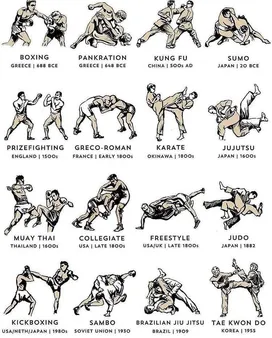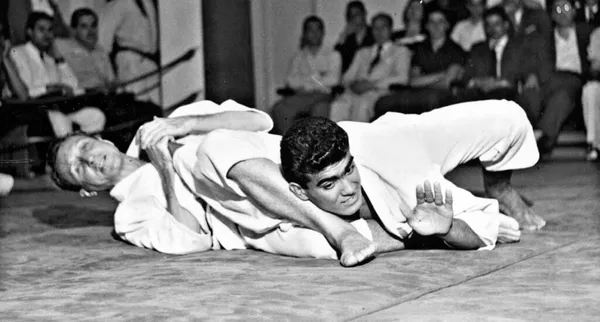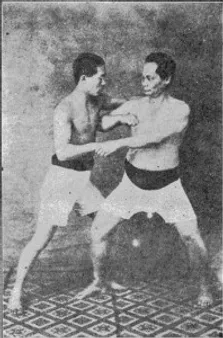Table of Contents
Embark on a captivating journey through The history and origins of kickboxing, a martial art that seamlessly blends the power of karate, the finesse of Muay Thai, and the strategic brilliance of Western boxing. From its humble beginnings in ancient civilizations to its modern-day status as a globally recognized sport, kickboxing has captivated audiences with its exhilarating matches and empowered individuals with its transformative benefits. At Kizworld, we delve into the rich tapestry of kickboxing's past, exploring its evolution from ancient arenas to modern-day rings, and uncovering the stories of legendary fighters who shaped this dynamic sport.
The History and Origins of Kickboxing: A Journey Through Time
I. Rise of kickboxing in Japan
Rise of kickboxing in Japan
During the 1960s and 1970s, a new form of combat sport emerged in Japan that would change the martial arts world forever: kickboxing. This hybrid fighting style blended techniques from karate, Muay Thai, Western boxing, and other disciplines, creating a dynamic and exciting sport that captured the imagination of martial artists and spectators alike.
The rise of kickboxing in Japan can be attributed to several factors. First, the country had a long and rich history of martial arts, with many people practicing karate, judo, and other traditional styles. This created a fertile environment for the development of new fighting systems, and kickboxing was able to thrive in this atmosphere. Second, Japan was a major center for professional boxing, and the popularity of this sport helped to legitimize kickboxing in the eyes of the public.
Year | Event |
|---|---|
1966 | First professional kickboxing match in Japan |
1970 | First World Kickboxing Championship |
1975 | Kickboxing becomes a professional sport in Japan |
Third, the Japanese people were generally receptive to new and innovative ideas, and they were eager to try out this new fighting style. Kickboxing quickly became a popular sport in Japan, and it soon spread to other countries around the world.
The popularity of kickboxing in Japan
Kickboxing quickly became a popular sport in Japan for several reasons. First, it was a very exciting and dynamic sport to watch. The fast-paced action and the powerful strikes made for a thrilling spectacle that kept fans on the edge of their seats. Second, kickboxing was a very effective form of self-defense. The techniques that were taught in kickboxing classes were very practical and could be used in real-world situations.
Third, kickboxing was a great way to get in shape. The intense workouts that were required to prepare for a kickboxing match helped people to burn calories, build muscle, and improve their overall fitness.
Finally, kickboxing was a very accessible sport. Unlike some other martial arts, which required years of training to master, kickboxing could be learned relatively quickly. This made it a popular choice for people who were looking for a new way to get in shape and learn self-defense without having to spend years of training.
- The Best Kickboxing Equipment and Gear
- How to Learn the Basic Kickboxing Skills and Techniques
- The Top Kickboxing Competitions and Events
The rise of kickboxing in Japan had a profound impact on the world of martial arts. It helped to introduce new techniques and training methods to the world, and it also helped to legitimize the sport of kickboxing in the eyes of the public. Today, kickboxing is one of the most popular martial arts in the world, and it continues to grow in popularity every year.
II. Influence of Muay Thai in Modern Kickboxing
Influence of Muay Thai in Modern Kickboxing
Muay Thai, the "Art of Eight Limbs," has indelibly influenced the evolution of modern kickboxing. Its captivating techniques, rhythmic footwork, and devastating striking power have left an undeniable mark on this dynamic combat sport. Kickboxing, a hybrid martial art, seamlessly blends elements of Muay Thai, Western boxing, and other striking disciplines, creating a thrilling spectacle of power, precision, and athleticism.
The influence of Muay Thai in kickboxing is evident in several key areas:
- Striking Techniques: Kickboxing incorporates a diverse arsenal of striking techniques that originate from Muay Thai, including powerful kicks, sharp elbows, and devastating knees. These techniques add versatility and unpredictability to a kickboxer's attack.
- Footwork and Movement: Muay Thai's distinctive footwork patterns, characterized by rhythmic hopping, side-stepping, and agile movement, provide kickboxers with exceptional maneuverability and evasiveness.
- Clinch Work: Muay Thai's grappling and clinch techniques, such as the clinch and the plum, have been adopted into kickboxing, allowing fighters to control their opponents and set up powerful strikes from close range.
- Training Methods: The rigorous training methods of Muay Thai, emphasizing pad work, sparring, and intense physical conditioning, have been embraced by kickboxing gyms, contributing to the development of well-rounded and explosive fighters.
Kickboxing's adoption of Muay Thai techniques has elevated the sport to new heights, producing thrilling matches and captivating audiences worldwide. The fusion of these martial arts has created a unique and dynamic discipline that continues to captivate fight fans and inspire martial artists around the globe.
Muay Thai's impact on kickboxing can be seen in the styles of some of the most successful kickboxers in history. For instance, Ramon Dekkers, a Dutch kickboxing legend, was renowned for his devastating Muay Thai-inspired techniques, earning him the moniker "The Diamond." Similarly, John Wayne Parr, an Australian kickboxing champion, mesmerized fans with his exceptional Muay Thai skills, including his lightning-fast kicks and knees.
In conclusion, the influence of Muay Thai in modern kickboxing is undeniable. Its techniques, strategies, and training methods have significantly contributed to the sport's identity, creating a thrilling and captivating martial art that continues to captivate audiences worldwide.
Explore related articles:
- What is Kickboxing?
- History of Kickboxing
- Kickboxing Techniques
- Kickboxing Training
- Kickboxing Competitions
- Famous Kickboxers
III. From Japan to the World
From Japan to the World
Kickboxing's journey from its Japanese roots to its global recognition is a captivating tale of cultural exchange and martial arts evolution. In the 1960s, Japanese karate masters sought to create a more realistic and effective fighting system that incorporated elements of Western boxing. This fusion of techniques gave birth to kickboxing, which quickly gained popularity in Japan and spread to other parts of Asia.
The 1970s marked a pivotal moment for kickboxing as it made its way to the United States. American martial artists were intrigued by this dynamic and challenging sport, and soon kickboxing gyms and tournaments began to emerge across the country. The popularity of kickboxing continued to soar in the 1980s and 1990s, thanks in part to the rise of mixed martial arts (MMA) competitions, which showcased the effectiveness of kickboxing techniques in a full-contact setting.
Country | Year of Introduction |
Japan | 1960s |
United States | 1970s |
Europe | 1980s |
South America | 1990s |
Australia | 2000s |
Today, kickboxing is practiced and enjoyed by people of all ages and fitness levels around the world. It is a popular choice for those seeking a challenging workout, self-defense skills, or simply a fun and engaging way to stay active. Kickboxing classes can be found in most major cities, and there are numerous organizations and associations dedicated to promoting and regulating the sport.
The global reach of kickboxing is a testament to its versatility and appeal. Whether you are a seasoned martial artist or a complete beginner, kickboxing offers something for everyone. With its dynamic techniques, intense workouts, and empowering self-defense skills, kickboxing continues to captivate and inspire people worldwide.
- How to Learn Kickboxing for Self-Defense and Fitness
- The Benefits of Kickboxing for Physical and Mental Health
- The Best Kickboxing Equipment and Gear
IV. The History and Origins of Kickboxing
Kickboxing combines elements of karate, Muay Thai, and Western boxing. It is a dynamic and challenging sport that can be enjoyed by people of all ages and fitness levels. Kickboxing has a rich history, dating back to ancient civilizations, where warriors sought to combine the striking prowess of karate and Muay Thai with the strategic footwork of Western boxing. Over time, kickboxing evolved into a modern-day sport, captivating audiences worldwide with its thrilling matches and empowering individuals with its transformative benefits.Martial arts have a long and storied history, and kickboxing is a relatively new addition to the scene, having only emerged in the 20th century. However, it has quickly gained popularity as a competitive sport and a form of self-defense.
V. The Benefits of Kickboxing
Kickboxing offers numerous physical and mental benefits, making it an ideal workout for people looking to improve their overall fitness, relieve stress, and boost their confidence.
- Improved cardiovascular health: Kickboxing is an excellent cardiovascular workout that gets your heart rate up and helps you burn calories.
- Increased muscle strength and tone: Kickboxing helps you build muscle strength and tone in your arms, legs, and core.
- Improved flexibility and balance: Kickboxing helps you improve your flexibility and balance, which can reduce your risk of injury.
- Stress relief: Kickboxing can be a great way to relieve stress and pent-up energy, helping you feel more relaxed and invigorated.
- Boosted confidence: Kickboxing can help you boost your confidence and self-esteem, as you learn new skills and achieve your fitness goals.
VI. How to Get Started with Kickboxing
If you are interested in trying kickboxing, there are a few things you need to do to get started. First, find a reputable kickboxing gym or instructor. Once you have found a gym or instructor, you can start taking classes. Kickboxing classes typically include a warm-up, technique instruction, and a workout. As you progress, you can start sparring with other students.
Equipment | Description |
|---|---|
Hand wraps | Protect your hands from blisters and injuries. |
Boxing gloves | Protect your hands and knuckles while striking. |
Shin guards | Protect your shins from kicks. |
Mouthguard | Protect your teeth and mouth from injury. |
Headgear | Protect your head from injury during sparring. |
VII. Conclusion
Kickboxing has come a long way since its humble beginnings in ancient Greece. Today, it is a globally recognized sport with millions of practitioners worldwide. Whether you are interested in self-defense, fitness, or competition, kickboxing has something to offer everyone. Its dynamic and challenging nature provides a full-body workout that improves cardiovascular health, strength, and flexibility. It also teaches valuable lessons in discipline, focus, and perseverance. As you continue your kickboxing journey, remember to embrace the challenge, stay patient, and never give up on your goals. The rewards are well worth the effort.